Solar eclipse of January 3, 1908
| Solar eclipse of January 3, 1908 | |
|---|---|
| Type of eclipse | |
| Nature | Total |
| Gamma | 0.1934 |
| Magnitude | 1.0437 |
| Maximum eclipse | |
| Duration | 254 s (4 min 14 s) |
| Coordinates | 11°48′S 145°06′W / 11.8°S 145.1°W |
| Max. width of band | 149 km (93 mi) |
| Times (UTC) | |
| Greatest eclipse | 21:45:22 |
| References | |
| Saros | 130 (46 of 73) |
| Catalog # (SE5000) | 9299 |
A total solar eclipse occurred at the Moon's descending node of orbit between Friday, January 3 and Saturday, January 4, 1908,[1][2][3][4][5] with a magnitude of 1.0437. A solar eclipse occurs when the Moon passes between Earth and the Sun, thereby totally or partly obscuring the image of the Sun for a viewer on Earth. A total solar eclipse occurs when the Moon's apparent diameter is larger than the Sun's, blocking all direct sunlight, turning day into darkness. Totality occurs in a narrow path across Earth's surface, with the partial solar eclipse visible over a surrounding region thousands of kilometres wide. Occurring about 14 hours before perigee (on January 4, 1908, at 12:30 UTC), the Moon's apparent diameter was larger.[6]
Totality was visible from Ebon Atoll in German New Guinea (now in Marshall Islands), British Western Pacific Territories (the part now belonging to Kiribati), Line Islands (now in Kiribati), Phoenix Islands (now in Kiribati) on January 4 (Saturday), and Costa Rica on January 3 (Friday). A partial eclipse was visible for parts of northern Oceania, Hawaii, southern North America, Central America, the western Caribbean, and western South America.
Observations
[edit]The eclipse was observed by astronomer William Wallace Campbell of Lick Observatory, viewed from Flint Island, Kiribati, an uninhabited island in the Line Islands. The team of Lick Observatory departed from San Francisco on November 22, 1907, and arrived in Papeete, Tahiti Island, the capital of French Polynesia on December 4. After making preparations of supplies and logistics personnel, it departed again on the evening of December 7 and arrived at Flint Island on the afternoon of the 9:[7]
Astronomers from the Royal Astronomical Society, Sydney Observatory and surveyors from New Zealand also observed the total eclipse near the observation site of Lick Observatory. The team successfully took images of the corona.[8]
Eclipse details
[edit]Shown below are two tables displaying details about this particular solar eclipse. The first table outlines times at which the moon's penumbra or umbra attains the specific parameter, and the second table describes various other parameters pertaining to this eclipse.[9]
| Event | Time (UTC) |
|---|---|
| First Penumbral External Contact | 1908 January 03 at 19:07:37.2 UTC |
| First Umbral External Contact | 1908 January 03 at 20:03:19.2 UTC |
| First Central Line | 1908 January 03 at 20:04:02.0 UTC |
| First Umbral Internal Contact | 1908 January 03 at 20:04:44.8 UTC |
| First Penumbral Internal Contact | 1908 January 03 at 21:02:14.0 UTC |
| Ecliptic Conjunction | 1908 January 03 at 21:43:22.3 UTC |
| Equatorial Conjunction | 1908 January 03 at 21:45:11.7 UTC |
| Greatest Eclipse | 1908 January 03 at 21:45:21.4 UTC |
| Greatest Duration | 1908 January 03 at 21:45:57.9 UTC |
| Last Penumbral Internal Contact | 1908 January 03 at 22:28:29.5 UTC |
| Last Umbral Internal Contact | 1908 January 03 at 23:25:57.2 UTC |
| Last Central Line | 1908 January 03 at 23:26:40.8 UTC |
| Last Umbral External Contact | 1908 January 03 at 23:27:24.4 UTC |
| Last Penumbral External Contact | 1908 January 04 at 00:23:04.0 UTC |
| Parameter | Value |
|---|---|
| Eclipse Magnitude | 1.04375 |
| Eclipse Obscuration | 1.08941 |
| Gamma | 0.19334 |
| Sun Right Ascension | 18h52m47.6s |
| Sun Declination | -22°53'44.4" |
| Sun Semi-Diameter | 16'16.0" |
| Sun Equatorial Horizontal Parallax | 08.9" |
| Moon Right Ascension | 18h52m48.0s |
| Moon Declination | -22°41'55.4" |
| Moon Semi-Diameter | 16'41.7" |
| Moon Equatorial Horizontal Parallax | 1°01'16.1" |
| ΔT | 7.7 s |
Eclipse season
[edit]This eclipse is part of an eclipse season, a period, roughly every six months, when eclipses occur. Only two (or occasionally three) eclipse seasons occur each year, and each season lasts about 35 days and repeats just short of six months (173 days) later; thus two full eclipse seasons always occur each year. Either two or three eclipses happen each eclipse season. In the sequence below, each eclipse is separated by a fortnight.
| January 3 Descending node (new moon) |
January 18 Ascending node (full moon) |
|---|---|
 |

|
| Total solar eclipse Solar Saros 130 |
Penumbral lunar eclipse Lunar Saros 142 |
Related eclipses
[edit]Eclipses in 1908
[edit]- A total solar eclipse on January 3.
- A penumbral lunar eclipse on January 18.
- A penumbral lunar eclipse on June 14.
- An annular solar eclipse on June 28.
- A penumbral lunar eclipse on July 13.
- A penumbral lunar eclipse on December 7.
- A hybrid solar eclipse on December 23.
Metonic
[edit]- Preceded by: Solar eclipse of March 17, 1904
- Followed by: Solar eclipse of October 22, 1911
Tzolkinex
[edit]- Preceded by: Solar eclipse of November 22, 1900
- Followed by: Solar eclipse of February 14, 1915
Half-Saros
[edit]- Preceded by: Lunar eclipse of December 27, 1898
- Followed by: Lunar eclipse of January 8, 1917
Tritos
[edit]- Preceded by: Solar eclipse of February 1, 1897
- Followed by: Solar eclipse of December 3, 1918
Solar Saros 130
[edit]- Preceded by: Solar eclipse of December 22, 1889
- Followed by: Solar eclipse of January 14, 1926
Inex
[edit]- Preceded by: Solar eclipse of January 22, 1879
- Followed by: Solar eclipse of December 13, 1936
Triad
[edit]- Preceded by: Solar eclipse of March 4, 1821
- Followed by: Solar eclipse of November 3, 1994
Solar eclipses of 1906–1909
[edit]This eclipse is a member of a semester series. An eclipse in a semester series of solar eclipses repeats approximately every 177 days and 4 hours (a semester) at alternating nodes of the Moon's orbit.[10]
The partial solar eclipses on February 23, 1906 and August 20, 1906 occur in the previous lunar year eclipse set.
| Solar eclipse series sets from 1906 to 1909 | ||||||
|---|---|---|---|---|---|---|
| Ascending node | Descending node | |||||
| Saros | Map | Gamma | Saros | Map | Gamma | |
| 115 | July 21, 1906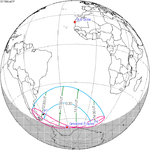 Partial |
−1.3637 | 120 | January 14, 1907 Total |
0.8628 | |
| 125 | July 10, 1907 Annular |
−0.6313 | 130 | January 3, 1908 Total |
0.1934 | |
| 135 | June 28, 1908 Annular |
0.1389 | 140 | December 23, 1908 Hybrid |
−0.4985 | |
| 145 | June 17, 1909 Hybrid |
0.8957 | 150 | December 12, 1909 Partial |
−1.2456 | |
Saros 130
[edit]This eclipse is a part of Saros series 130, repeating every 18 years, 11 days, and containing 73 events. The series started with a partial solar eclipse on August 20, 1096. It contains total eclipses from April 5, 1475 through July 18, 2232. There are no annular or hybrid eclipses in this set. The series ends at member 73 as a partial eclipse on October 25, 2394. Its eclipses are tabulated in three columns; every third eclipse in the same column is one exeligmos apart, so they all cast shadows over approximately the same parts of the Earth.
The longest duration of totality was produced by member 30 at 6 minutes, 41 seconds on July 11, 1619. All eclipses in this series occur at the Moon’s descending node of orbit.[11]
| Series members 41–62 occur between 1801 and 2200: | ||
|---|---|---|
| 41 | 42 | 43 |
 November 9, 1817 |
 November 20, 1835 |
 November 30, 1853 |
| 44 | 45 | 46 |
 December 12, 1871 |
 December 22, 1889 |
 January 3, 1908 |
| 47 | 48 | 49 |
 January 14, 1926 |
 January 25, 1944 |
 February 5, 1962 |
| 50 | 51 | 52 |
 February 16, 1980 |
 February 26, 1998 |
 March 9, 2016 |
| 53 | 54 | 55 |
 March 20, 2034 |
 March 30, 2052 |
 April 11, 2070 |
| 56 | 57 | 58 |
 April 21, 2088 |
 May 3, 2106 |
 May 14, 2124 |
| 59 | 60 | 61 |
 May 25, 2142 |
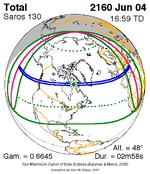 June 4, 2160 |
 June 16, 2178 |
| 62 | ||
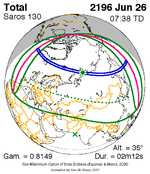 June 26, 2196 | ||
Metonic series
[edit]The metonic series repeats eclipses every 19 years (6939.69 days), lasting about 5 cycles. Eclipses occur in nearly the same calendar date. In addition, the octon subseries repeats 1/5 of that or every 3.8 years (1387.94 days). All eclipses in this table occur at the Moon's descending node.
| 22 eclipse events between March 16, 1866 and August 9, 1953 | ||||
|---|---|---|---|---|
| March 16–17 | January 1–3 | October 20–22 | August 9–10 | May 27–29 |
| 108 | 110 | 112 | 114 | 116 |
 March 16, 1866 |
 August 9, 1877 |
 May 27, 1881 | ||
| 118 | 120 | 122 | 124 | 126 |
 March 16, 1885 |
 January 1, 1889 |
 October 20, 1892 |
 August 9, 1896 |
 May 28, 1900 |
| 128 | 130 | 132 | 134 | 136 |
 March 17, 1904 |
 January 3, 1908 |
 October 22, 1911 |
 August 10, 1915 |
 May 29, 1919 |
| 138 | 140 | 142 | 144 | 146 |
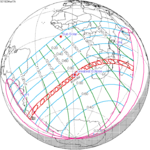 March 17, 1923 |
 January 3, 1927 |
 October 21, 1930 |
 August 10, 1934 |
 May 29, 1938 |
| 148 | 150 | 152 | 154 | |
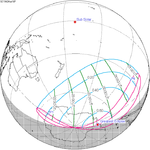 March 16, 1942 |
 January 3, 1946 |
 October 21, 1949 |
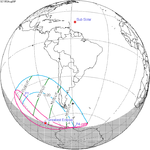 August 9, 1953 | |
Tritos series
[edit]This eclipse is a part of a tritos cycle, repeating at alternating nodes every 135 synodic months (≈ 3986.63 days, or 11 years minus 1 month). Their appearance and longitude are irregular due to a lack of synchronization with the anomalistic month (period of perigee), but groupings of 3 tritos cycles (≈ 33 years minus 3 months) come close (≈ 434.044 anomalistic months), so eclipses are similar in these groupings.
| Series members between 1801 and 2200 | ||||
|---|---|---|---|---|
 October 9, 1809 (Saros 121) |
 September 7, 1820 (Saros 122) |
 August 7, 1831 (Saros 123) |
 July 8, 1842 (Saros 124) |
 June 6, 1853 (Saros 125) |
 May 6, 1864 (Saros 126) |
 April 6, 1875 (Saros 127) |
 March 5, 1886 (Saros 128) |
 February 1, 1897 (Saros 129) |
 January 3, 1908 (Saros 130) |
 December 3, 1918 (Saros 131) |
 November 1, 1929 (Saros 132) |
 October 1, 1940 (Saros 133) |
 September 1, 1951 (Saros 134) |
 July 31, 1962 (Saros 135) |
 June 30, 1973 (Saros 136) |
 May 30, 1984 (Saros 137) |
 April 29, 1995 (Saros 138) |
 March 29, 2006 (Saros 139) |
 February 26, 2017 (Saros 140) |
 January 26, 2028 (Saros 141) |
 December 26, 2038 (Saros 142) |
 November 25, 2049 (Saros 143) |
 October 24, 2060 (Saros 144) |
 September 23, 2071 (Saros 145) |
 August 24, 2082 (Saros 146) |
 July 23, 2093 (Saros 147) |
 June 22, 2104 (Saros 148) |
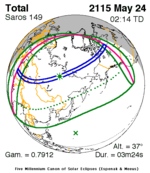 May 24, 2115 (Saros 149) |
 April 22, 2126 (Saros 150) |
 March 21, 2137 (Saros 151) |
 February 19, 2148 (Saros 152) |
 January 19, 2159 (Saros 153) |
 December 18, 2169 (Saros 154) |
 November 17, 2180 (Saros 155) |
 October 18, 2191 (Saros 156) | ||||
Inex series
[edit]This eclipse is a part of the long period inex cycle, repeating at alternating nodes, every 358 synodic months (≈ 10,571.95 days, or 29 years minus 20 days). Their appearance and longitude are irregular due to a lack of synchronization with the anomalistic month (period of perigee). However, groupings of 3 inex cycles (≈ 87 years minus 2 months) comes close (≈ 1,151.02 anomalistic months), so eclipses are similar in these groupings.
| Series members between 1801 and 2200 | ||
|---|---|---|
 March 4, 1821 (Saros 127) |
 February 12, 1850 (Saros 128) |
 January 22, 1879 (Saros 129) |
 January 3, 1908 (Saros 130) |
 December 13, 1936 (Saros 131) |
 November 23, 1965 (Saros 132) |
 November 3, 1994 (Saros 133) |
 October 14, 2023 (Saros 134) |
 September 22, 2052 (Saros 135) |
 September 3, 2081 (Saros 136) |
 August 15, 2110 (Saros 137) |
 July 25, 2139 (Saros 138) |
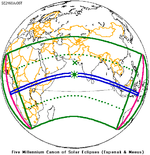 July 5, 2168 (Saros 139) |
 June 15, 2197 (Saros 140) |
|
Notes
[edit]- ^ "January 3–4, 1908 Total Solar Eclipse". timeanddate. Retrieved 31 July 2024.
- ^ "Obscured by the clouds". The Journal and Tribune. Knoxville, Tennessee. 1908-01-04. p. 8. Retrieved 2023-11-01 – via Newspapers.com.
- ^ "Clouds hide eclipse; many are disappointmented". St. Louis Globe-Democrat. St. Louis, Missouri. 1908-01-04. p. 1. Retrieved 2023-11-01 – via Newspapers.com.
- ^ "FLINT ISLAND PARTY VIEWS SUN ECLIPSE". The San Francisco Examiner. San Francisco, California. 1908-01-04. p. 6. Retrieved 2023-11-01 – via Newspapers.com.
- ^ "The sun's obscuration". The Daily Telegraph. Sydney, New South Wales, Australia. 1908-01-04. p. 10. Retrieved 2023-11-01 – via Newspapers.com.
- ^ "Moon Distances for London, United Kingdom, England". timeanddate. Retrieved 31 July 2024.
- ^ Powerhouse Museum. "Solar Eclipse, Flint Island, Kiribati, 1908". Powerhouse Museum, Australia. Retrieved 11 March 2016.
- ^ Sebastian Albrecht. "The Lick Observatory-Crocker Expedition to Flint Island". Journal of the Royal Astronomical Society of Canada. 2: 115–131. Archived from the original on 23 August 2019.
- ^ "Total Solar Eclipse of 1908 Jan 03". EclipseWise.com. Retrieved 31 July 2024.
- ^ van Gent, R.H. "Solar- and Lunar-Eclipse Predictions from Antiquity to the Present". A Catalogue of Eclipse Cycles. Utrecht University. Retrieved 6 October 2018.
- ^ "NASA - Catalog of Solar Eclipses of Saros 130". eclipse.gsfc.nasa.gov.
References
[edit]- Earth visibility chart and eclipse statistics Eclipse Predictions by Fred Espenak, NASA/GSFC
- Photo of Solar Corona January 3, 1908





